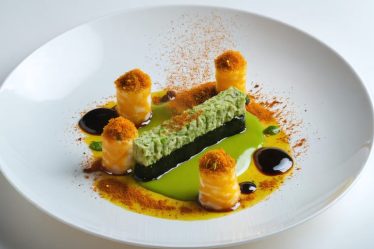
Sustainable dining revolutionizes the way we experience luxury restaurants, transforming each meal into an environmentally conscious celebration of flavor and responsibility. Today’s most innovative chefs aren’t just creating masterpieces on the plate – they’re pioneering a movement that connects exquisite cuisine with environmental stewardship.
Picture walking into a high-end restaurant where every detail, from the locally foraged mushrooms to the regeneratively farmed beef, tells a story of conscious cultivation. The wine in your glass comes from biodynamic vineyards, while the vegetables gracing your plate were harvested just hours ago from the restaurant’s own rooftop garden. Even the elegant table settings reflect this commitment, with linens made from organic materials and centerpieces crafted from rescued florals.
This isn’t just a trend – it’s a fundamental shift in how the culinary world approaches luxury dining. Leading restaurants are proving that sustainability and sophistication aren’t mutually exclusive; rather, they’re essential partners in creating memorable dining experiences that nourish both our palates and our planet. As diners become increasingly conscious of their environmental impact, sustainable fine dining offers a guilt-free way to indulge in world-class cuisine while supporting practices that protect our environment for future generations.
The Farm-to-Table Revolution in Fine Dining
Local Partnerships That Transform Menus
When Chef Maria Santos partnered with Blue Hill Farm just outside the city, she didn’t expect it would completely revolutionize her restaurant’s menu. “Working directly with local farmers has opened my eyes to ingredients I never knew existed,” she shares. This partnership, focused on seasonal sourcing, has brought unique heritage vegetables and heirloom varieties to her tables.
At Harvest Table, owner James Chen collaborates with three local farms, each specializing in different products. “Our menu changes weekly based on what’s thriving in their fields,” he explains. This arrangement has led to creative dishes like purple carrot tartare and watermelon radish carpaccio, delighting guests while supporting local agriculture.
These partnerships go beyond simple supplier relationships. Farmers often join restaurant staff meetings, sharing their growing processes and suggesting creative uses for upcoming harvests. This collaboration has sparked menu innovations across the city, with chefs discovering forgotten varieties and traditional farming methods that add depth to their culinary stories.
The impact extends to the community too. Regular farm-to-table events bring diners closer to their food sources, while restaurants often feature farmer profiles on their menus, creating a deeper connection between plate and producer. These partnerships have proven that sustainable dining isn’t just about environmental responsibility – it’s about creating a vibrant, interconnected food community that benefits everyone involved.
Restaurant Gardens: The Ultimate Source Control
Last summer, I had the pleasure of dining at The Garden Table, where my caprese salad featured tomatoes picked just hours before from their rooftop garden. It’s experiences like these that showcase why restaurant gardens are becoming the gold standard in sustainable dining.
More restaurants are transforming unused spaces into thriving gardens, from compact herb boxes to extensive rooftop operations. These garden-to-table initiatives aren’t just about sustainability – they’re about delivering unparalleled freshness and flavor that discerning diners can taste in every bite.
Chef Maria Santos of Harvest Kitchen explains, “When you can pick herbs moments before service or harvest vegetables at peak ripeness, it completely transforms the dining experience. There’s simply no comparison to ingredients that have traveled hundreds of miles.”
Beyond the obvious environmental benefits of reducing transportation emissions and packaging waste, restaurant gardens give chefs unprecedented control over their ingredients. They can experiment with heritage varieties, ensure organic growing practices, and time harvests perfectly with their menu needs.
Many establishments are even turning their gardens into educational spaces, offering guests tours and cooking classes. It’s a beautiful way to connect diners with their food’s origin story while demonstrating a genuine commitment to sustainability.
The result? Dishes that are not just environmentally conscious but burst with authentic, vibrant flavors that simply can’t be replicated with conventional sourcing methods.

Sustainable Seafood: The New Standard in Gourmet

Ocean-Friendly Certification Programs
When I first started exploring sustainable dining, those little seafood certification labels left me puzzled. Now, I understand they’re like nature’s seal of approval, telling us which seafood choices help protect our oceans. The most recognized certification is the Marine Stewardship Council (MSC) blue fish label, which ensures the seafood comes from well-managed fisheries that maintain healthy fish populations.
Another important certification to look for is the Aquaculture Stewardship Council (ASC) label for farmed seafood. These certifications help restaurants offer sustainable seafood options while maintaining their commitment to exceptional quality.
The Ocean Wise symbol is particularly prevalent in North American restaurants, making it easier for diners to identify ocean-friendly choices. When you see these certifications at your favorite restaurant, you can feel confident that your seafood selection supports responsible fishing practices and ocean conservation.
Many high-end restaurants now proudly display these certifications on their menus and websites, showing their dedication to both culinary excellence and environmental stewardship. It’s wonderful to see how these programs have transformed from niche initiatives into mainstream standards for quality dining establishments.
Seasonal Catch Menus
Imagine walking into your favorite restaurant and discovering that last month’s tuna tartare has been replaced with a vibrant local mackerel ceviche. This isn’t just a chef’s whim – it’s a thoughtful approach to sustainable dining that more restaurants are embracing through seasonal catch menus.
I recently chatted with Chef Maria Santos, who explained how her restaurant updates its seafood offerings based on marine breeding cycles and local availability. “When we respect the seasons, we’re not just serving fresher fish – we’re giving marine populations time to replenish,” she shared. This practice helps maintain healthy ocean ecosystems while treating diners to peak-season flavors.
Restaurants following this approach typically work closely with local fishers who understand regional marine patterns. They might feature Atlantic cod in winter, switch to Pacific halibut in spring, and highlight wild salmon during summer runs. Some establishments even offer daily catch specials that depend entirely on what local boats bring in that morning.
This flexible approach to menu planning requires creativity from chefs but results in more exciting dining experiences. Plus, seasonal seafood often costs less than out-of-season options, making sustainable choices more accessible for both restaurants and diners.
Zero-Waste Kitchen Practices
Creative Repurposing in Fine Dining
In the world of fine dining, today’s most innovative chefs are proving that one person’s food scraps can become another’s culinary masterpiece. Through creative zero-waste cooking practices, these culinary artists are transforming what was once destined for the compost bin into sought-after dishes that delight both the palate and conscience.
Take, for instance, the humble carrot top, often discarded without a second thought. At leading sustainable restaurants, these greens are being transformed into vibrant pestos or dehydrated into garnishes that add both visual appeal and depth of flavor. Fish bones and seafood shells, traditionally tossed aside, now form the basis of rich, complex broths that elevate dishes to new heights.
I recently visited Chef Maria Santos’s acclaimed restaurant, where she showed me how potato peels become crispy garnishes that add texture to elegant plates. “Every ingredient has potential,” she shared, “it’s about seeing beauty in what others might overlook.” Even coffee grounds find new life in creative desserts, adding subtle notes of richness to chocolate-based creations.
What’s particularly inspiring is how these practices not only reduce waste but often result in signature dishes that guests specifically request. When vegetable trimmings become fermented garnishes and fruit scraps transform into elegant syrups for craft cocktails, it’s clear that sustainability and luxury can perfectly coexist on the same plate.

Composting Programs and Circular Systems
I recently visited a restaurant that completely changed my perspective on food waste. Instead of sending scraps to landfills, they’ve created a beautiful partnership with local farms that feels like a perfect circle of sustainability.
More restaurants are discovering that composting isn’t just good for the environment – it’s good for business too. Kitchen scraps, coffee grounds, and even paper napkins are collected and transformed into rich, nutrient-dense compost that local farmers use to grow the very ingredients that will eventually return to restaurant kitchens.
This farm-to-table-to-farm approach is gaining momentum across the dining industry. Many establishments now work with specialized composting services that handle collection and distribution to nearby farms. Some restaurants have even invested in their own composting systems, creating educational opportunities for staff and customers alike.
The benefits ripple throughout the community. Farmers receive free, high-quality compost, restaurants reduce their waste management costs, and diners enjoy fresh, locally-grown produce. It’s especially heartwarming to see how these programs often spark conversations between chefs and farmers, leading to deeper relationships and more sustainable food systems.
For those interested in supporting these initiatives, ask your favorite restaurants about their composting practices. Many are proud to share their sustainability stories and welcome customer engagement in their environmental efforts.
The Future of Sustainable Fine Dining
Technology’s Role in Sustainable Sourcing
Technology has revolutionized the way restaurants approach sustainable sourcing, making it easier than ever to track food from farm to table. Just last week, I visited a local restaurant where the chef showed me how they use a smartphone app to verify the origin of their seafood – it was fascinating to see the entire journey of my salmon dinner!
Modern tracking systems now allow restaurants to monitor their ingredients’ journey in real-time, ensuring freshness while reducing food miles. Smart inventory management systems help chefs predict exactly how much produce they’ll need, significantly cutting down on food waste. These tools can even suggest creative ways to use ingredients that might otherwise go to waste.
Blockchain technology is making waves in sustainable dining by creating transparent supply chains. Diners can scan a QR code on their menu to learn about their meal’s origins, from the farmer who grew the vegetables to the exact date of harvest. It’s like having a digital storyteller sharing the journey of every ingredient on your plate.
Apps and platforms are also connecting restaurants directly with local farmers and producers, cutting out middlemen and reducing transportation emissions. Some restaurants even use AI-powered systems to analyze their carbon footprint and suggest more sustainable alternatives for their menu items.
For conscious diners like us, these technological advances mean we can enjoy our meals with complete confidence in their sustainability credentials. It’s amazing how something as simple as a smartphone app can help us make more environmentally responsible dining choices.
Consumer-Driven Changes
Today’s diners are becoming increasingly conscious about their environmental impact, and their preferences are reshaping the restaurant industry from the inside out. As someone who frequently enjoys a fine dining experience, I’ve noticed how customer demand has pushed establishments to embrace sustainable practices while maintaining their commitment to excellence.
Many restaurants now proudly showcase their farm-to-table partnerships and locally sourced ingredients because diners actively seek this information. We’re asking more questions about where our food comes from, how it’s produced, and what happens to the waste – and restaurants are listening. This shift in consumer awareness has encouraged chefs to create seasonal menus that celebrate local produce and reduce carbon footprints.
Social media has amplified this trend, with diners sharing and celebrating restaurants that prioritize sustainability. From packaging choices to water conservation efforts, consumers are voting with their wallets and showing preference for establishments that align with their environmental values.
The demand for plant-based options has also surged, prompting even traditional restaurants to expand their vegetarian and vegan offerings. What’s particularly exciting is seeing how this consumer-driven change has inspired creative culinary innovations, proving that sustainability and gastronomic excellence can go hand in hand.
Restaurants that adapt to these preferences often find themselves rewarded with loyal customers who appreciate their commitment to both environmental stewardship and exceptional dining experiences.
As we look to the future of gourmet dining, it’s clear that sustainability isn’t just a trend – it’s becoming the gold standard of culinary excellence. I’ve watched this transformation firsthand, seeing how chefs and restaurateurs are reimagining fine dining through an eco-conscious lens without compromising on the artistry and innovation that makes it special.
The marriage of sustainable practices and haute cuisine is creating exciting new possibilities. Restaurants that embrace these principles are discovering that environmental responsibility often leads to more creative, flavorful, and meaningful dining experiences. From my conversations with leading chefs, I’ve learned that working with seasonal, local ingredients not only reduces environmental impact but also pushes their culinary boundaries in unexpected ways.
The ripple effects extend far beyond individual restaurants. When prestigious establishments champion sustainability, they influence the entire industry. Small-scale farmers are finding new markets, traditional farming methods are being preserved, and diners are developing deeper connections with their food’s origins.
Looking ahead, I believe sustainable fine dining will continue to evolve, shaped by technological innovations, changing consumer preferences, and environmental necessities. The restaurants that thrive will be those that successfully balance luxury with responsibility, creating memorable experiences that nourish both their guests and our planet.
For those of us who love fine dining, this evolution promises a future where exceptional food goes hand in hand with environmental stewardship – and that’s something worth raising a glass to.



